Pop culture has always been integral to the LGBTQ community. As media is something that everyone encounters in their daily lives, making gayness visible has the ability to bring acceptance, break barriers, and give comfort to those who relate.
For lesbians, representation of our lives and culture reached a landmark in the ‘90s. No longer being ignored, many lesbian characters and public figures opened the door for us to be out and loud about our love for women. Inclusion grew massively within cinema, music, and television, which empowered an entire generation of dykes in full force. From “The Puppy Episode” to “Bound,” let’s celebrate the ten most iconic lesbian pop culture moments that occurred during this glorious decade.
Ellen Degeneres’ Groundbreaking Coming Out
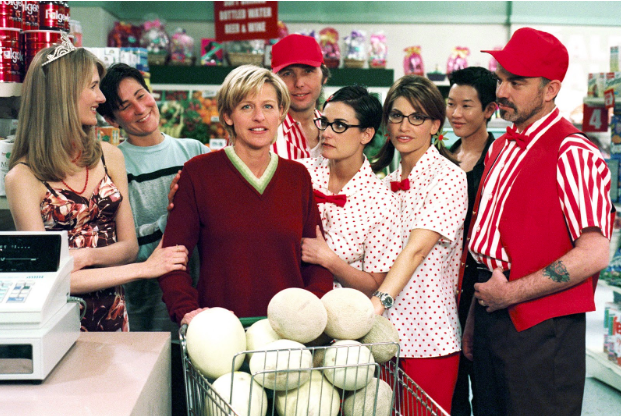
In one of the bravest career moves of all time, Ellen Degeneres took gay representation to the next level in 1997. Just a couple weeks after declaring her sexuality on the cover of Time magazine, the fictional version of herself came out as well on her ABC sitcom Ellen. Titled “The Puppy Episode” to keep the true narrative under wraps, the two-part story is fun, relatable, and still feels ahead of its time 21 years later. Though it nearly destroyed her career, the courageous-as-ever Degeneres not only paved the way for lesbian visibility, but later went on to become one of the most successful talk show hosts in America.
“Go Fish” Makes a Splash

I’m completely obsessed with this Rose Troche-directed indie flick. A genuine and comedic depiction of community, coming out, and the awkwardness of lesbian dating, her film makes me more confident in my gayness every time I watch it. After a triumphant Sundance premiere and impressive box office earnings in 1994, “Go Fish” demonstrated that lesbian life, love, and culture were marketable to audiences.
Melissa Etheridge Releases Lesbian Anthem “Come to My Window”
Just a few months after publicly coming out as a lesbian in 1993, Melissa Etheridge released “Come to My Window.” The third track off of her fourth record, Yes I Am, the lyrics deal with emotional, intense love inspired by her girlfriend at the time, Julie Cypher. Following a chart-topping release, the lesbian anthem earned Etheridge her second Grammy Award for Best Female Rock Vocal Performance.
k.d. lang Graces the Cover of Vanity Fair
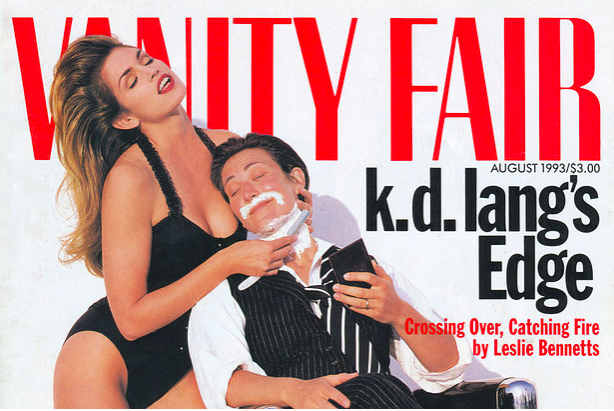
Canadian pop/country singer k.d. lang came out as a lesbian in 1992 shortly after the release of her second album, Ingénue. Jump to August 1993, lang is featured on the cover of mainstream magazine Vanity Fair, dressed up in a sleek suit while being shaved by model Cindy Crawford: an unforgettable treasure that celebrates the beauty of butchness.
Xena and Gabrielle Become Sapphic Icons

In a time of ancient gods, warlords, and kings, lesbians in turmoil cried out for a hero. That hero would be none other than the titular character of Xena: Warrior Princess — as well as her traveling companion Gabrielle — who both made their TV debut in 1995. Xena and Gabrielle were always close, but the romantic vibes between them couldn’t be ignored even if you tried. Because of this, Xena gained a cult following within the lesbian community, and the act of “shipping” is clearly indebted to her and Gabrielle’s legacy. Lucy Lawless, who played Xena, established fans’ wishes even more in a 2003 interview with Lesbian News, noting, “Now it wasn’t just that Xena was bisexual and kinda liked her gal pal and they kind of fooled around sometimes, it was, ‘Nope, they’re married, man.’”
Cheryl Dunye Makes Herstory with “The Watermelon Woman”

Known as the first feature directed by a Black lesbian, Cheryl Dunye released her film “The Watermelon Woman “in 1996. The drama follows an aspiring filmmaker (played by Dunye) who works at a video rental store in Philadelphia. After discovering an uncredited Black actress, she decides to learn more about her by making a documentary about her life. Besides being groundbreaking, Dunye’s innovative and upbeat movie gave birth to an experimental genre of docu-fiction, dubbed the “Dunyementary.”
Dyke Punk is on the Rise
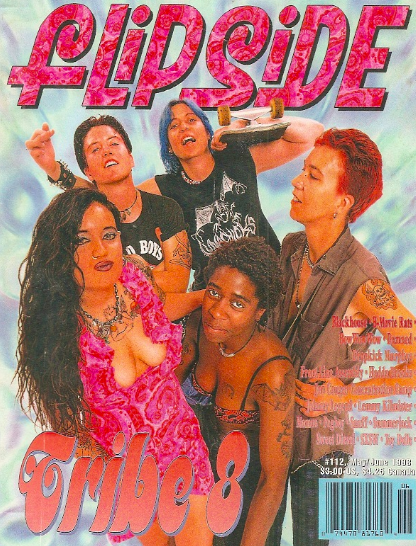
While bands like Bikini Kill and Sleater-Kinney were bringing notoriety to the riot grrrl movement of the ‘90s, queercore was gaining more attention as well. Dyke punk groups were all the rage, with acts like Fifth Column, Team Dresch, The Butchies, and Tribe 8 (whose rad name is derived from a play on tribadism) were unabashedly forcing the genre to evolve in both sound and inclusivity.
Gina Gershon and Jennifer Tilly Make Us Gayer In “Bound”
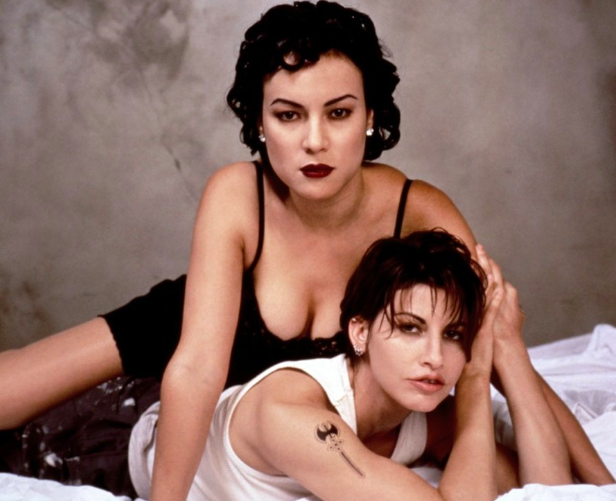
I know I’m not the only one who wanted a labrys tattoo after becoming obsessed with this movie. Before “The Matrix,” the Wachowski sisters made their directorial debut with “Bound” in 1996. Gershon and Tilly play Corky and Violet, respectively, a lesbian couple longing to break away from their pasts. Before this, lesbian romance had never been depicted so unapologetically in a mainstream genre film.
Lesbian Issues and Culture Gain Attention with Dyke TV
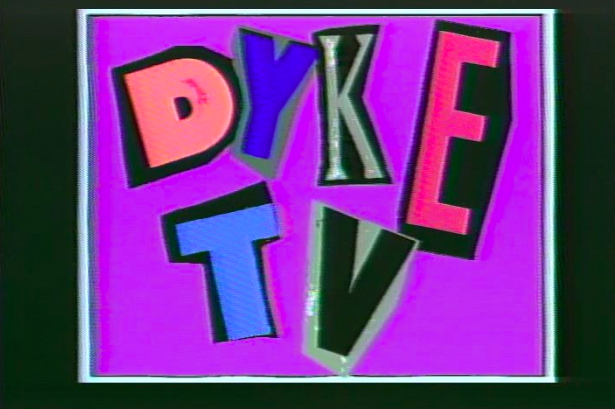
Debuting its first episode in 1993, the goal of Dyke TV was to do exactly what the show’s opening lines read: incite, subvert, provoke, and organize. Founded in New York City by Ana Maria Simo (also co-founder of activist group the Lesbian Avengers), Linda Chapman, and Mary Patierno, their creation covered lesbian-related news and issues from an intersectional lens through topics like art, music, cinema, and politics. Dyke TV ran weekly for 12 years, airing on dozens of public stations around the country.
Angelina Jolie Captures Hearts In “Gia” Biopic
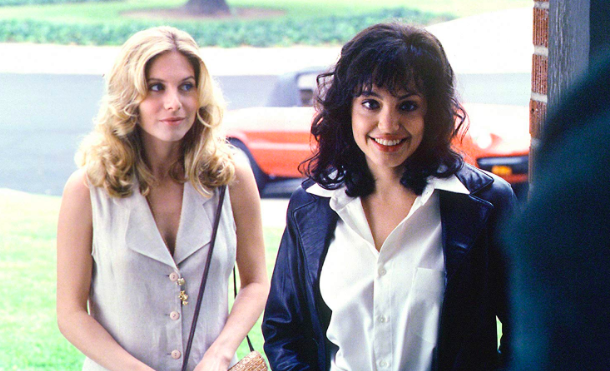
Based on the tragic life of Gia Marie Carangie, Jolie plays the supermodel who brought “lesbian chic” into existence before it became a thing. The biopic heavily focuses on her relationship with another woman, and the wild but lovable ways Gia wooed her. As the film was broadcast on HBO, “Gia” contains one of the first lesbian sex scenes that could be watched on cable.
Which lesbian pop culture moment of the ‘90s means the most to you? Let us know in the comments below!

What Do You Think?